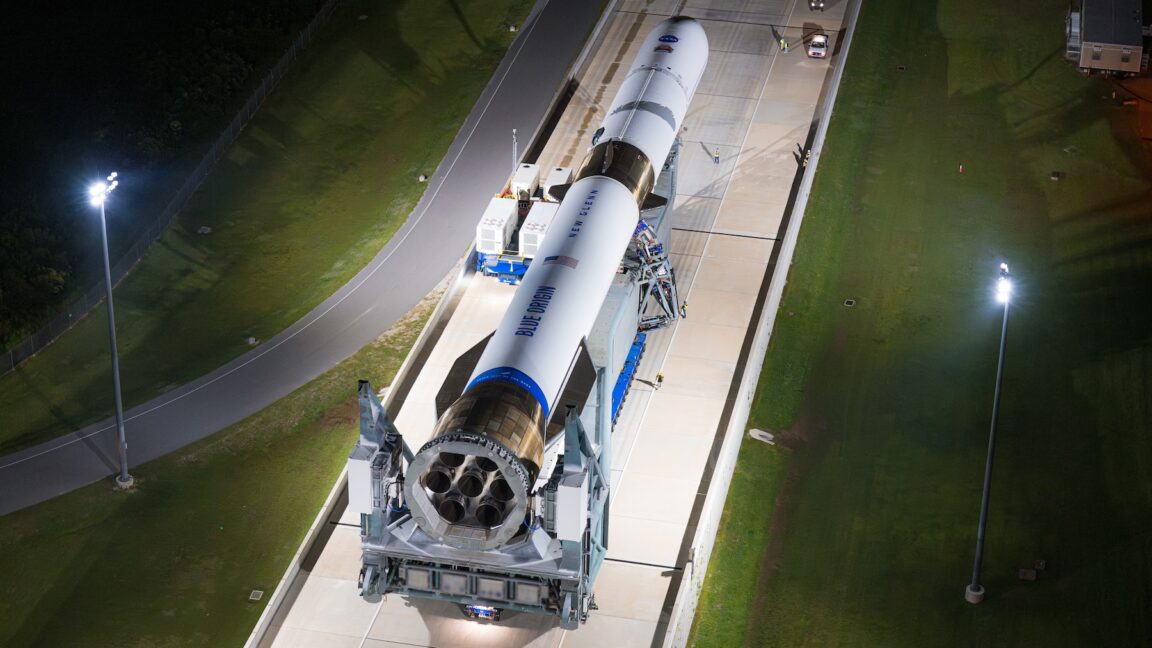Science
NASA’s ESCAPADE Mission Launches on Unique Trajectory to Mars

NASA is set to launch its ESCAPADE mission to Mars, employing an unconventional trajectory that allows the spacecraft to depart from Earth despite a delayed launch window. The mission, which stands for Escape and Plasma Acceleration and Dynamics Explorers, is scheduled for liftoff aboard Blue Origin’s New Glenn rocket from Cape Canaveral, Florida, on Sunday, October 1, 2023. This innovative approach marks a significant moment in astrodynamics, as mission planners adapt to the realities of planetary alignment and vehicle readiness.
Rob Lillis, the principal investigator at the University of California, Berkeley, explained that this mission is taking a unique path. “ESCAPADE is pursuing a very unusual trajectory in getting to Mars,” he stated. Instead of following the typical Hohmann transfer windows, which occur every 25 to 26 months, the spacecraft will enter a loiter orbit around Earth. This allows it to wait until Earth and Mars align correctly in November 2025, before continuing its journey to the red planet.
Originally, ESCAPADE was designed to follow a direct route to Mars, a journey that usually takes between six to nine months. However, due to a failure to meet the launch schedule last year, the spacecraft will now set off when Mars is over 220 million miles away. The next launch window for Mars missions does not occur until late 2026, underscoring the significance of this launch.
Despite the challenges, there are advantages to the current plan. The New Glenn rocket, a two-stage vehicle, is capable of carrying a significant payload to Mars, yet NASA is only sending approximately 1 ton of equipment, specifically twin science probes designed to study the interaction of Mars’ upper atmosphere with solar wind. The space agency secured a favorable deal with Blue Origin, paying about $20 million for the launch, considerably less than other options available for similar missions.
The launch carries inherent risks, notably because this is only the second flight of the New Glenn rocket, which has yet to receive full certification from NASA or the US Space Force. NASA typically avoids using unproven rockets for high-value missions, but the lower cost allowed for a different risk assessment. The total cost of the ESCAPADE mission is under $80 million, which is significantly lower than recent Mars missions.
Although the New Glenn rocket’s first test flight in January 2023 was successful, preparations for the second launch experienced delays. Engineers took extra time to ensure the vehicle would be ready, leading to the current launch window. Currently, the New Glenn rocket is poised for launch, with liftoff expected during an 88-minute launch window opening at 14:45 EST (19:45 UTC). Blue Origin forecasts a 65 percent chance of favorable weather for the event.
Blue Origin’s launch director Megan Lewis will oversee the countdown. The rocket will be fueled with super-cold liquid methane and liquid oxygen in the hours leading up to launch. After final checks, the countdown will proceed, culminating in the ignition of the rocket’s seven BE-4 engines, generating over 3.8 million pounds of thrust. The rocket will then ascend, shedding its first stage about three minutes into the flight, before the second stage ignites to propel the ESCAPADE satellites toward deep space.
The spacecraft will be directed to a location beyond the Moon known as the L2 Lagrange point. This gravitationally stable position will allow the satellites to enter a loiter orbit, where they will remain until the optimal time to head for Mars in late 2025. The innovative trajectory, described by Jeff Parker, a mission designer from Advanced Space, resembles a kidney bean shape, allowing flexibility in launch timing.
This unique staging orbit does come with trade-offs. The satellites will face increased exposure to radiation and may consume more fuel than initially estimated, affecting reserves allocated for scientific observations. Built by Rocket Lab, the satellites include extra propulsion capacity designed to accommodate various rocket launches.
Richard French, Vice President of Business Development and Strategy at Rocket Lab, noted that although the mission carries higher risks due to its unique trajectory, NASA deemed the risk acceptable given the mission’s budget constraints and objectives.
The ESCAPADE mission exemplifies innovative approaches in space exploration, showcasing a flexible method for future Mars missions. As Lillis remarked, “It will demonstrate an exciting and flexible way to get to Mars,” potentially paving the way for future missions to send numerous spacecraft to the red planet simultaneously.
-

 World4 months ago
World4 months agoScientists Unearth Ancient Antarctic Ice to Unlock Climate Secrets
-

 Politics3 days ago
Politics3 days agoSecwepemc First Nation Seeks Aboriginal Title Over Kamloops Area
-

 Entertainment4 months ago
Entertainment4 months agoTrump and McCormick to Announce $70 Billion Energy Investments
-

 Lifestyle4 months ago
Lifestyle4 months agoTransLink Launches Food Truck Program to Boost Revenue in Vancouver
-

 Science4 months ago
Science4 months agoFour Astronauts Return to Earth After International Space Station Mission
-

 Technology2 months ago
Technology2 months agoApple Notes Enhances Functionality with Markdown Support in macOS 26
-

 Top Stories4 weeks ago
Top Stories4 weeks agoUrgent Update: Fatal Crash on Highway 99 Claims Life of Pitt Meadows Man
-

 Sports4 months ago
Sports4 months agoSearch Underway for Missing Hunter Amid Hokkaido Bear Emergency
-

 Politics3 months ago
Politics3 months agoUkrainian Tennis Star Elina Svitolina Faces Death Threats Online
-

 Politics4 months ago
Politics4 months agoCarney Engages First Nations Leaders at Development Law Summit
-

 Technology4 months ago
Technology4 months agoFrosthaven Launches Early Access on July 31, 2025
-

 Top Stories2 weeks ago
Top Stories2 weeks agoFamily Remembers Beverley Rowbotham 25 Years After Murder





















